Introduction:
It should be noted that householders and private contractors are not permitted to amend or alter an existing line of road kerbs forming part of a public highway without the consent and approval of the local authority highways department.
Road kerbs serve a number of purposes:
- - retaining the carriageway edge to prevent 'spreading' and loss of structural integrity
- - acting as a barrier or demarcation between road traffic and pedestrians or verges
- - providing physical 'check' to prevent vehicles leaving the carriageway
- - forming a channel along which surface water can be drained
There are many different types of road kerbs used throughout Britain and Ireland. 50 years ago, natural stone, such as granite, was the most popular, but these have now been supplanted by pre-cast concrete. In restricted areas experiencing exceptionally heavy traffic, such as town or city centres, steel kerbs have been used to cope with the constant over-running of vehicles, and on our motorways and dual carriageways, extruded kerb lines are commonly used.
Extruded kerbs
This form of kerb edging is normally only found on large road schemes, such as motorways and dual carriageways. The kerb is formed from concrete or asphalt and is produced by machine, usually as an adjunct to the surfacing work. They are more common on the long straight, monotonous roads and highways of North America and Australia than it is in Britain and Europe, although the concrete form has been popular in Ireland.
Extruded concrete kerbs are usually formed by the use of specially shaped plates fitted to a Slip-Form Paver machine which then creates the kerb as it progresses along the carriageway. Extruded asphalt kerbs are commonly formed in a special extruding machine and are bonded to the existing asphalt surface. Half-battered or splayed profiles are the commonest forms used on highways in Britain and Ireland.
Adjustments to line and level of extruded kerbs is a bit of a chore, and for that reason, they tend to be used primarily on long, straight, unbroken runs, rather than the twisting, winding, up-hill-and-down-dale roads we have in Britain and Ireland.
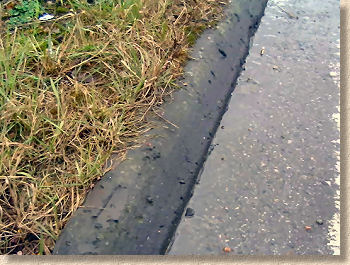
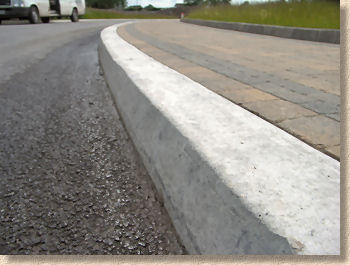
Recently, a smaller version of the kerb-extruding machine has been developed and decorative extruded kerbs for private driveways and landscaping projects have become possible. The system is operated as a franchise - see....
Natural Stone
Natural stone is very durable, but is also expensive. Granite is a popular choice, but whinstone, gabbro, basalt and sandstone may also be used. While the stone kerbs used nowadays are dressed to a standard profile and finish, they come in random lengths, up to 2 metres or so. Older kerbs, some having provided well over 100 years of service, may not match a standard profile and consequently repairing or replacing these units can be a problem for Highways Authorities.
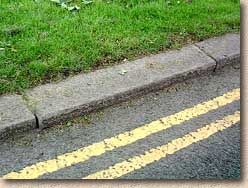
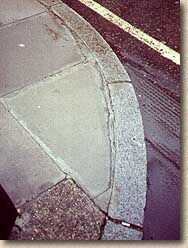
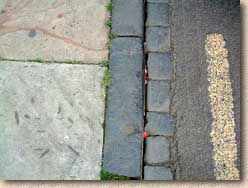
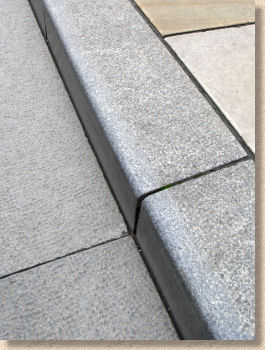
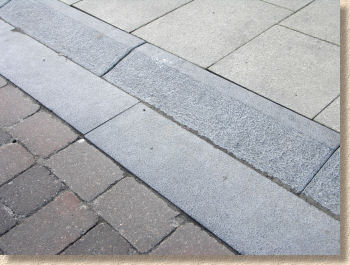
Pre-cast Concrete
Pre-cast concrete units are now the most popular choice for kerbing. Hydraulically-pressed kerbs are strong, durable, cheap and can be manufactured to strict tolerances ( BS EN 1340 ). There are some special shapes, notably quadrants and some droppers, which are still manufactured from vibrated concrete, although this material isn't as strong as a pressed concrete.
Standard kerbs have a pimpled finish and come in a fetching shade of concrete grey. More decorative (and therefore more expensive) kerbs are becoming popular on prestige and 'Heritage' schemes, with features such as exposed aggregates and textured finishes.
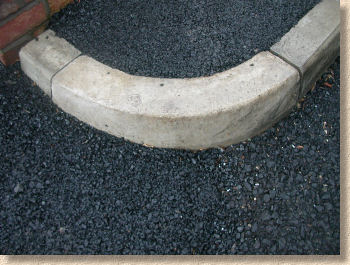
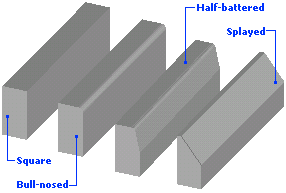
There are 4 basic profiles to the most common, pcc road kerbs used throughout Britain.
- Half-battered
- Bull-nosed
- Splayed
- Square
Traditionally, most straight kerbs are 915mm in length (a hangover from the pre-metric days), although some of the kerb-units developed to match block-paving are only 100mm or 200mm long. Radius kerbs , ie those designed to form curves of less than 10m radius, are shorter than the equivalent straight units and the most modern ranges are being manufactured as 780mm in length.
All kerbs, other than those with a square profile, have what is known as a 'watermark' or a 'waterline'. This is a line on the face above which surfacing (and therefore surface water) is not normally expected to extend. In many cases, the surfacing level is kept 25mm or more below the watermark.
The watermark is not a physical mark but generally coincides with a change in angle of the kerb face.

The most commonly used pcc road kerbs are the half-battered profile. These provide an element of check sufficient to warn motorists that they are dangerously close to the edge of the carriageway, while the 'sloping back' profile enables road rollers to operate right up to the edge of the pavement without scratching or damaging the kerb face when the surfacing is laid. They are normally used where a footpath is provided adjacent to the carriageway.
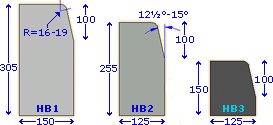
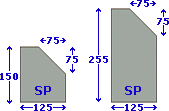
Splayed profile kerbs are used in those situations where a vehicle may need to 'bump up' onto a verge in an emergency. For safety reasons, these are not used when a footpath is present.
Where a crossing is required, normally for access to a private driveway, access point or pedestrian crossing, a bull-nosed or chamfered kerb is used. While the bull-nose kerb shown opposite is a British Standard kerb, the chamfered unit (in violet) is NOT and can only be obtained via certain manufacturers. The consent of the Local Authority Highways Department is required to use non-BS kerbs on public highways.

The pcc kerbs illustrated on this page are manufactured to prescribed sizes. The larger kerbs are approx. 125x255mm or 155x305mm, while the smaller units, are approx 125x155mm or 150x150mm. These smaller kerbs are typically used as 'crossing kerbs', on housing estate cul-de-sacs where no footpath is present, or in situations where a full-depth kerb would not be feasible, such as on a bridge deck.
Transition kerbs, or 'droppers' as they are sometimes called, are used to link two differing kerb profiles. These are most commonly seen on 'dropped crossings', as illustrated below.
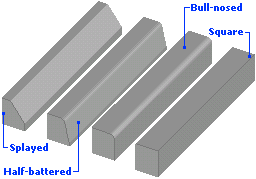
Lightweight pcc kerbs
Kerbs have always been heavy, cumbersome things and they take their toll on installers (as I can testify!), and so there has been a move within the industry, spurred on by health and safety concerns, to look at various options for reducing the wear and tear on kerb-layers.
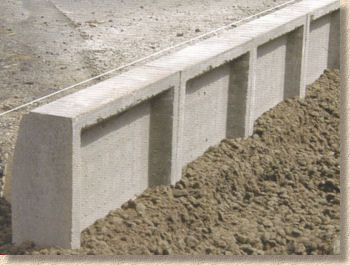
Along with machine-aided installation, one of the options considered is a lighter kerb, and the K-Lite manufactured by Charcon is a prime example. The kerb length has been reduced to a much more manageable 450mm, but the form of the kerb has also been altered, creating a frog (a recess) in the rear of the kerb unit, which dramatically reduces weight to just 20kg per unit. The frog is eventually filled with haunch concrete and there is no loss of performance from the completed kerbline - just fewer knackered kerb-layers!
Other lightweight kerb options are considered later on this page.
Special Kerbs
Other kerbs seen on the highways of the nations include....

Side Offlet Kerbs , sometimes known as Weir Kerbs, for use with behind-kerb drainage systems. They have largely been replaced by kerb-drain units nowadays, but they were quite popular 25+ years ago. They often have a cast iron or steel grille or facing to keep the worst of the street litter out of the sewers.
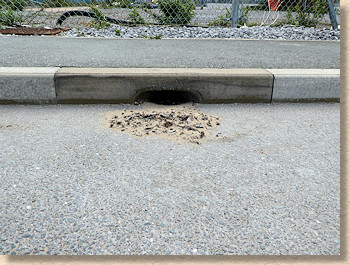
High Containment Kerb , such as the Trief or Titan kerbs . These are used to prevent traffic leaving the carriageway and are often used to protect vulnerable footpaths or sensitive roadside equipment, such as fuel pumps at filling stations, pedestrian islands, dangerous curves, etc.
These are BIG kerbs, measuring around 450mm in height and weighing almost a quarter of a tonne.
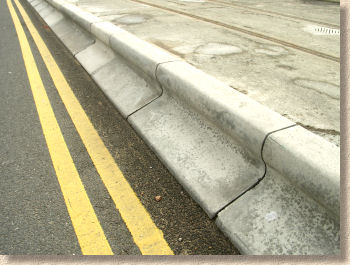
Bus Stop kerbs - a relatively new development designed to ease access of passengers using public transport. The height of the kerb is variable to suit local buses and there may be some tactile feature within the channel to help the bus driver align the vehicle correctly to minimise the gap between kerb and vehicle entrance, without rubbing the tyres against the face of the kerb.
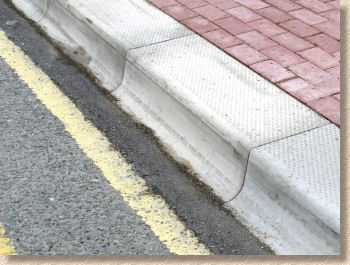
This type of kerb is expected to become more common as public transport systems in our towns and cities are expanded and enhanced with the increased usage of trams and other LRT systems over the coming years.
A detailed case study of the use and installation of the Kassel Bus Stop Kerb is provided on a separate page.
Kerb-Drain systems - another relatively modern development that has been readily adopted by many highway authorities because of its simplicity.
Essentially, it's a hollowed-out herb with gaping inlets on the face. Water from the carriageway falls into the internal 'pipe' and is then directed to a suitable place of disposal, either the SW system or a SUDS facility.
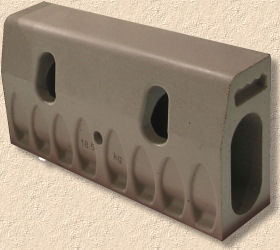
The early pcc versions were two-piece units comprising a U-shaped channel topped by an inverted U-shaped lid with the requisite inlets. The concept was rapidly re-interpreted by various manufacturers as single piece concrete or polymer concrete units of varying sizes and capacities.
More information can be found on the Linear Drainage page.
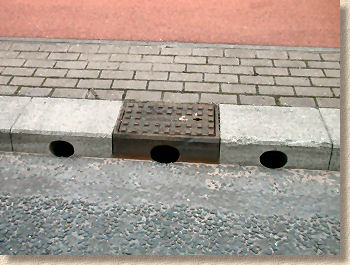
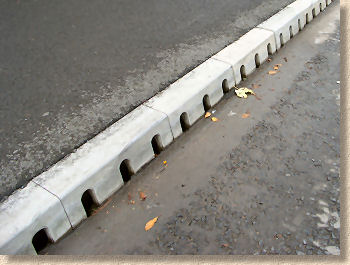
Textured and Decorative Kerbs
As mentioned earlier, this type of kerb is becoming increasingly popular on prestige projects and the burgeoning 'Heritage' Schemes that seem to be taking off in almost every town in the land.
There are several different types. Some are simply textured or exposed aggregate versions of the standard kerbs depicted above, while others are specially sized to offer better design possibilities, such as the 250mm wide units shown opposite.
There is a good range of radius units, quadrants, droppers/transitions to complement the straight units, and they can be used to create steps or other decorative features within a hard-landscape.
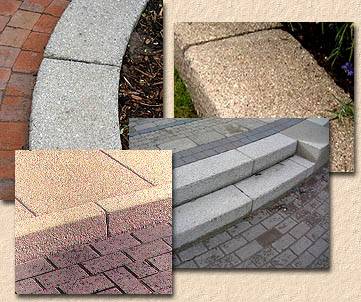
Block Paving (Small Unit) Kerbs
With the phenomenal growth in the use of block paving as a paving over the last couple of decades or so, decorative small unit kerbs that complement the scale, textures and colour schemes of block paving have been developed. While some of these units are specifically developed for private driveways and the like, there are several units that are, in effect, short versions of the standard road kerb profiles, notably the half-battered, the bull-nosed and the chamfered forms.
Although these units are not normally used on main or arterial roads, they are popular on the cul-de-sacs and feeder roads of modern residential estates.
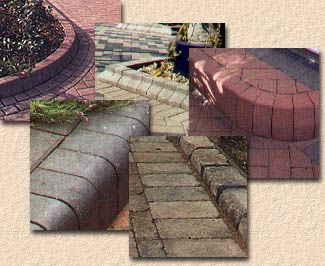
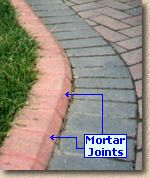
Where a curve or change in fall requires a joint to be left slightly open, it should be pointed with a 3:1 mortar, as described on the Mortars & Concretes page. The smaller, block paving kerb-units look tidier when pointed with a mortar of a complementary colour, with a 10-12mm joint between adjacent units. This is particularly true on slow curves where radius units are not used, but also on straight runs.
The block-paving kerb units are also very useful for constructing steps or terracing, as they provide a neat and tidy solution to forming vertical faces.
Plastic kerbs
As mentioned earlier , concerns regarding manual handling risks over recent years have prompted the development of lightweight kerbs manufactured from 'alternative' materials, most commonly recycled and modified plastics.
Many rely on the principle of a 'hollow' kerb which is filled (partially) with concrete as part of the laying process, and one manufacturer is able to produce full-sized (915mm long) half-battered kerbs weighing as little as 6kg.
Once installed, they are almost indistinguishable from standard pcc kerbs: there's a slight colour/texture difference but you'd hardly notice it when hurtling past at 30mph!
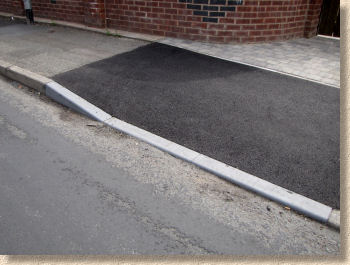
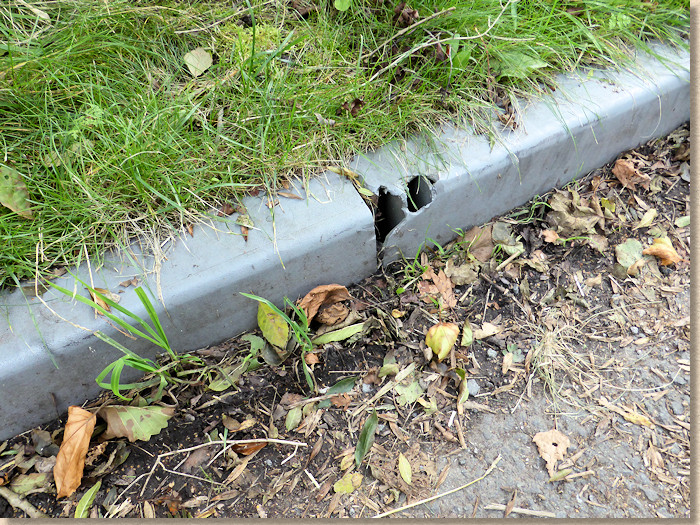
There are concerns with plastic kerbs, the most common ones being their fragility when impacted by a point load, which can result in the sort of damage seen in the photie above.
There was also a deal of concern about flammability and the risk of a vehicle fire being spread if the plastic used to manufacture the kerbs was to catch light. However, the better modern plastic kerbs have fire-retardants incorporated into the plastic to minimise such a risk.
Steel Kerbs (and channels)
There was a time when steel kerbs, some with integral channels, were not all that uncommon in heavy industrial areas. They can still be seen in the murky backstreets of some of our larger cities, but they are very, very rarely installed as new nowadays.
The main reason for there use was their resilience and longevity. In the days of iron-rimmed wheels on carts and carriages, even a kerb of a tough stone, such as granite, would rapidly be abraded, and the check it provided would be lost. This might then allow carts to 'cut corners' and so graze the adjacent buildings - remember, these industrial age backstreets tend to be narrow and confined with a minimal footway, if any.
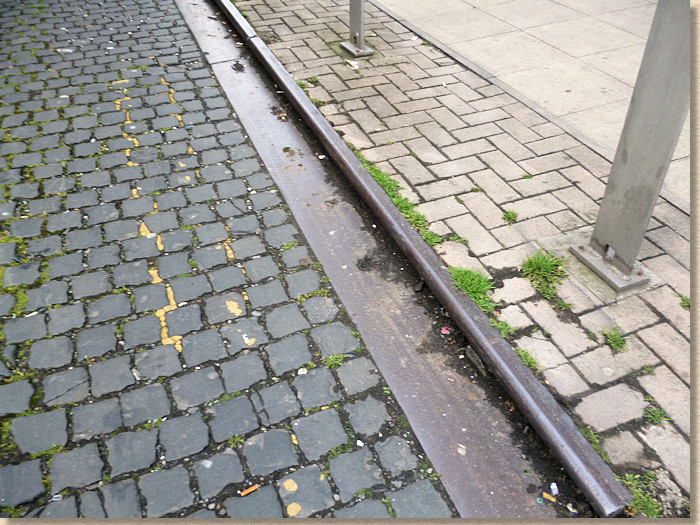
A steel kerb provided certainty. It would take a lot longer to abrade - iron rubbing against iron tends to even out - and so carts would stay 'on track' and their cargo would be kept in place and undamaged. More than that: the steel kerbs actually acted as an aid to steering in an age of fixed wheels, keeping them in place as tight corners were negotiated.
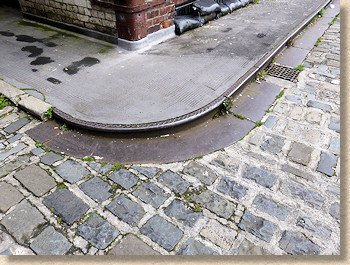
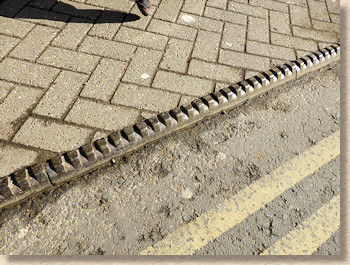
Steel kerbs weren't exclusive to indiustrial areas. They can sometimes be found in rural areas where the lack of any local hard stone to form a cart-resistant kerb caused the borough engineers to seek a suitable alternative, maybe something from the then-burgeoning railway industry?
The castellated kerbs above (backed by awful concrete block paving) are laid as 1 yard lengths (showing their pre-metric heritage) and were spotted in the anything-but-industrial village of Bourton-on-the-Water in rural Gloucestershire.
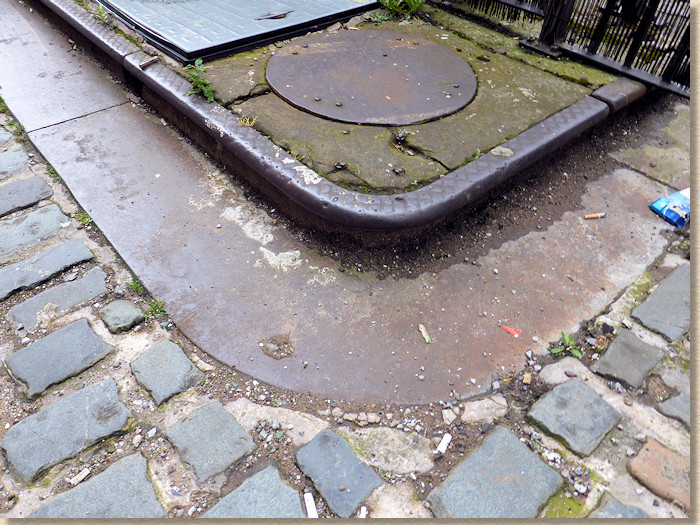
These are a vanishing rarity nowadays, but they represent history at our feet, showing how, even 150 years or more ago, clever streetmasons and dedicated engineers were coming up with novel ideas that would address the problems of the day. Where we now make specialist kerbs for pram crossings or fuel pump protection, back then it was about keeping carts in place and cargo intact.

While steel kerbs may be increasingly rare, there is a growing interest in the use of Steel Edgings as restraints for pathway and lighter pavements.
Find out more and follow an installation of steel edgings on this page
Channels
Channel kerbs were once a common sight at the edge of many roads, especially on carriageways where stone kerbs were used. They provided a 'gutter' for the drainage of surface water and provided a spacer between the edge of the macadam or asphalt and the face of the kerb. As pcc kerbs gradually replaced stone kerbs, pcc channels were often used in conjunction with them, but nowadays, they are rarely specified, unless they are used to create 'summits and valleys' adjacent to a relatively flat kerb line.
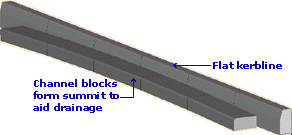
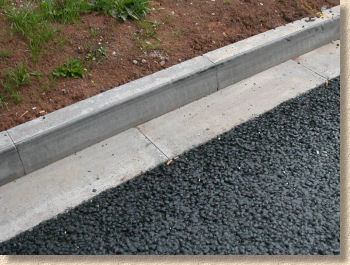
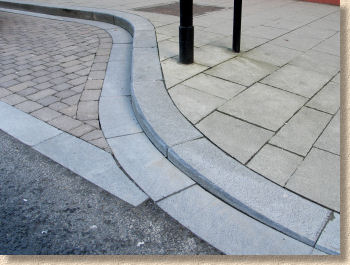
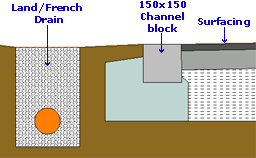
However, the units originally used as channel blocks still have their uses. They are often laid as a restraining edge to those carriageways where no check is required, usually access roads where surface water is shed to each side of the carriageway, or pavements where some form of drain is placed just outside the edge of the hard pavement. The 150x150mm channel blocks are perennial favourites for laying flush in this manner.
There are other channel kerbs that are more usually laid away from the edge of a pavement as an aid to drainage. These include dished or fluted channels. They can be used within footpaths or within low-speed vehicular areas, such as car parks. A larger version of the flat-bottomed dished channels are sometimes used as a combined edge restraint and drainage channel on motorways or dual carriageways.
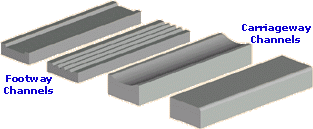
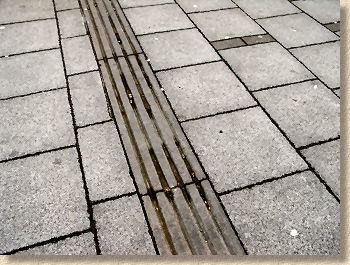
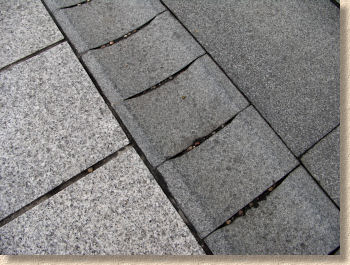
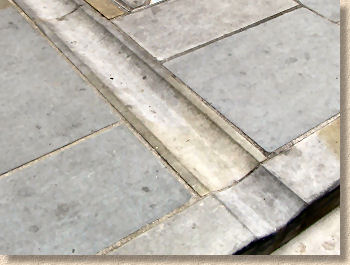
The success of linear channels has more or less seen the end of surface drainage channels for anything other than special jobs, such as the Yorkstone pavement shown opposite.
Dished channels are, rightly or wrongly, often regarded as a hazard for wheelchair users and prams, and so their use is now largely restricted to car parks, while fluted channels have virtually disappeared, despite there hardly being a week without someone asking where they can be obtained.
Radius Kerbs and Channels
A 'bend' in a kerb line is more correctly known as a 'radius'. As is shown on the Aligning Kerbs page, all bends, curves and arcs are composed of one or more radiuses (or radii, if you prefer). While it is possible to create a radius by using straight kerbs, there are both road kerbs and block-paving kerb units that are specially shaped to create true, accurate curves, either internal (concave) or external (convex).
In the construction trade, a radius or arc is often described as 'fast' or 'slow'. A fast arc has a shorter radius than a slow arc, so, for example, a 3m radius is said to be faster than a 4.5m radius, which is, in turn, faster than a 6m radius. There is no threshold beyond which all arcs are fast or slow - fast and slow are comparative, subjective terms. A 4.5m arc is slower than a 3m arc, but is faster than a 6m arc.
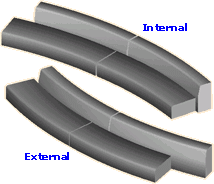
In general, any curve or arc of less than 12m radius in a line of road kerbs should be constructed using the nearest equivalent radius kerb. For arcs of intermediate sizes, it may be necessary to 'skew' the nearest slower radius unit, creating slightly open joints at the face, which can then be pointed with a mortar . Using the next faster radius kerb may result in a 'pinched' alignment, which can look awry.
For example, if a kerb line of 11.3m radius is required, this could be constructed using 12 metre radius units, with each kerb 'skewed' slightly to achieve the required alignment. See the Aligning Kerbs page for more information.
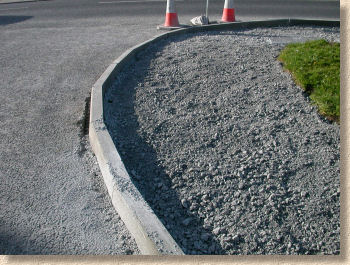
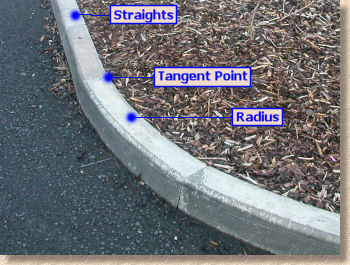
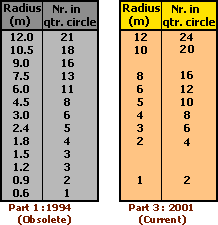
The tables opposite gives the number of radius kerbs required to create a quarter-circle (90°) under both the old British Standard (BS 7263) and the relatively new (well, 2003) BS EN 1340:2003 . The table is given purely for reference purposes.
Under the old standard, most kerbs were 915mm in length although the faster radii units (1.2m radius or less) were only 610mm long. With the new standard, all units are 780mm in length, which ensures a quarter-circle can be constructed using a whole number of kerbs.
Some manufacturers still produce 7363 standard kerbs as they are often needed for repairs to older highways.
The size of any radius can be determined by measuring the length of a chord subtended by the arc and then measuring a perpendicular to that chord at the centre. This is illustrated in the diagram below.
This is a handy equation often used on site to determine the size of an unknown radius that is to be kerbed, so that the correct size of radius kerbs can be used.

This method of determining the size of an existing kerb or arc is explored in much greater detail on a separate page.... Determining Kerb Radius
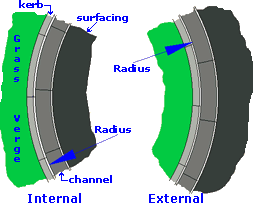
The size of a radius is ALWAYS measured to the face of the kerbline, whether the radius is internal or external. This applies to channel blocks as well as kerbs. In a situation such as that illustrated opposite, both the kerbs and the channel blocks are the same stated radial size.
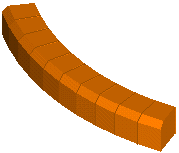
The radial block paving kerb units are generally only used on curves of less than 2.0m radius, internal or external. The actual true radius of these units is generally somewhere in the range 0.5m to 1.0m, and may need to be alternated with standard blocks to achieve a sweet curve of radius greater than 1.0m
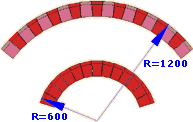
Quadrants and Angles
As well as the straight and radius kerbs, the manufacturers also supply units with complementary profiles specifically to form right-angles.
The drawing opposite illustrates the Internal and External angle units, and the Quadrant Block, sometimes known as a 'cheese'. The Quadrant Block can be cut with a power saw (and a lot of patience) to create angles of less than 90°

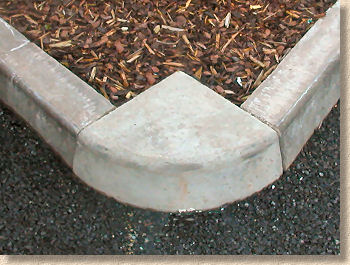
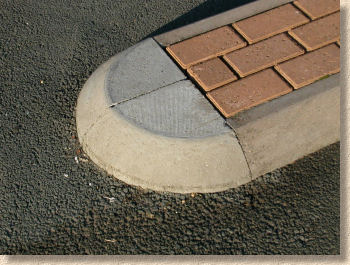
Quadrants are manufactured to match the usual kerb profiles and it's easy to see why they are sometimes known as cheeses. The concrete versions come in two sizes, 305mm or 455mm, with depth to suit the adjoining kerbs, but natural stone sizes can be different. Quadrants are kinder to vehicles tyres on busy car parks than external angles.
They can be used to connect orthogonal kerb lines, as shown above, or linked to create divider bays within car parks.
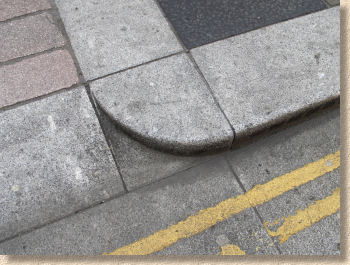
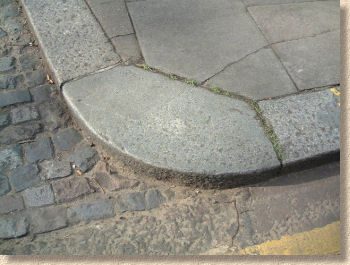
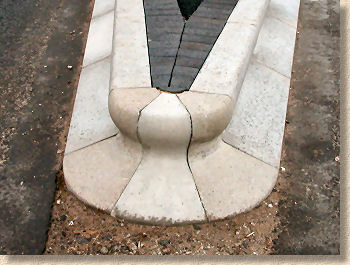
Non-standard kerb systems, such as the Trief kerbs shown opposite, as well as natural stone, often have complementary quadrants or cheeses. The crossing quadrant (top left) is an elegant yet simple detail for city centres, but unlike most other quadrants, it is 'handed', in that the unit used on the left-hand side of the crossing is not the same as that used on the right rotated through 90°
Internal and external angles are available to suit the most popular kerb profiles and are extremely useful on modular layouts, such as car parks, as they provide a neat solution to the problem of tie-ing in two kerb lines, and avoid the frustration and hard work of cutting a mitred angle with a power saw.
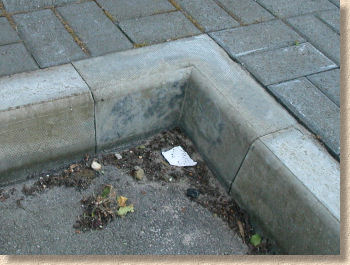
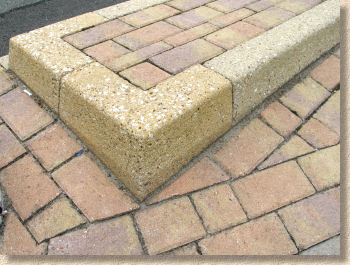
For most non-orthogonal angles a sawn mitre is still the only solution, but many stone suppliers will cut specific internal and external angles on request, such as the 45° internal angle shown here, cut from whinstone for a project in Perth.
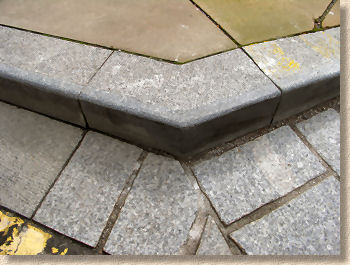
Droppers and Transition Kerbs
Dropper kerbs are primarily used to reduce the amount of check on a kerb face to allow easy access for foot and vehicular traffic at access points, such as private driveway crossings or pedestrian crossings. They are manufactured as either a right-handed or a left handed dropper, when viewed from the carriageway.
The illustration opposite shows a right-handed dropper being used to reduce the amount of check between half-battered road kerbs and bull-nosed kerbs used as 'centre stones' for a crossing point.
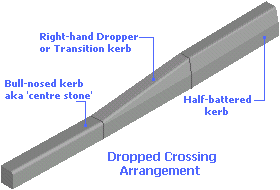
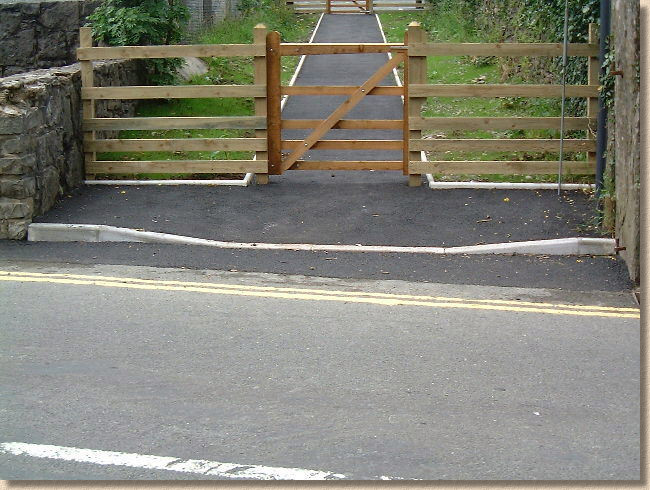
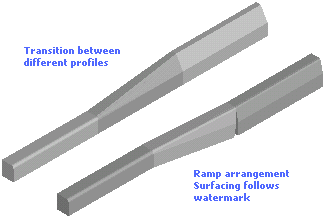
Other uses for these kerbs is as transitions between differing kerb profiles. The transition can 'dropped', as already decribed, or 'ramped', where the amount of check above the paving surface is increased/decreased by changing the level of the surfacing.
The ramped arrangement is commonly seen as the 'speed hump' on modern housing estates at the entrance to cul-de-sacs where there is no footpath. The ramp is often constructed from a different material, usually block paving or granite setts to create a 'rumble strip' that alerts drivers to reduce their speed.
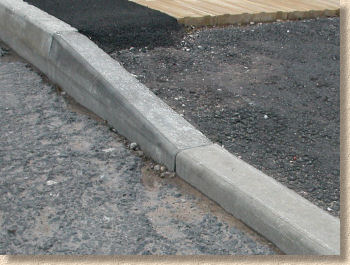
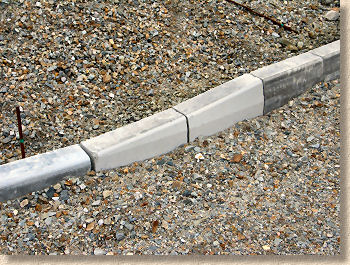
Some kerb types, especially the larger units such as the containment kerbs or bus stop kerbs , use two separate kerbs to achieve the transition from one type of kerb to the other. The droppers/transitions used with block paving kerbs also usually come in two parts.
When transitions or droppers are used within a radius, they are often sawn in half and laid at a skew to achieve a sweeter curve.
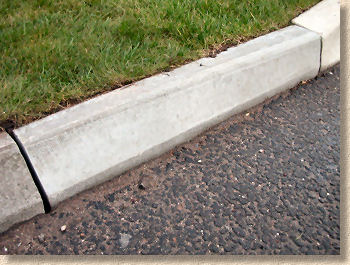
Construction
All kerbs should be laid on a concrete bed of at least 100mm thickness, and haunched to thickness of at least 150mm. The method of laying is covered in detail on the Concrete Bedded Edgings page and on the Aligning Kerbs page. A full-sized pavior's mall is preferred for tapping the kerbs down to the correct level.
It is usual to remove any concrete bedding from the front of the kerb, as this is said to prevent 'differential settlement' in subsequent paving. The joints are often not mortared, but are laid as tight to the preceding kerb as is possible, without risking spalling the units.
It is usual to leave 100-125mm of 'check', or 'upstand', on the 250 or 300mm high units, and 25-40mm on the smaller, 150mm high units, although there is some variation amongst local highway authorities. As mentioned earlier, the surfacing level never exceeds the watermark of the kerb, and is usually kept 25mm or even more below it. This is sometimes done to accommodate future re-surfacing of the carriageway, so that, for example, the top 25mm of an asphalt pavement can be planed off, and then overlaid with 50mm of new material, without breaching the kerb watermark.
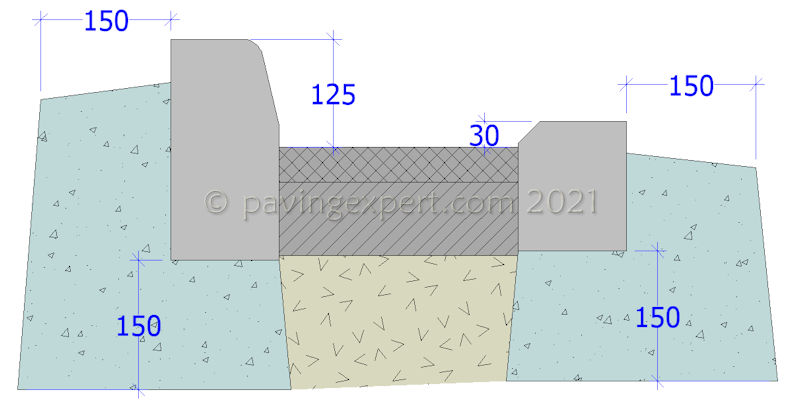
Video:
More info:

Pavingexpert.com is an approved BSI Affiliate, and so you can purchase standards and other documents via this page by clicking the link on each listed item. Any commission earned is used to fund the hosting and maintenance of the site.
- BS EN 1340 - Concrete Kerb Units
- BS EN 1343 - Natural Stone Kerbs
- BS 7533-6:1999 - Code of practice for laying natural stone, precast concrete and clay kerb units
Other Edgings & Kerbs Pages
- Edgings Main Page
- Types of edgings
- Steel Edgings
- Timber Edgings
- Laying on Concrete
- - Case Study Example
- - Profiling and Alignment
- - Bed Depth over a sub-base
- Mowing Strips
- Road Kerbs
- - Kassel Bus Stop Kerbs
- Sawtooth Edging
- Determining Kerb Radius
- Alternate edging systems for block paving
- Written Specification
